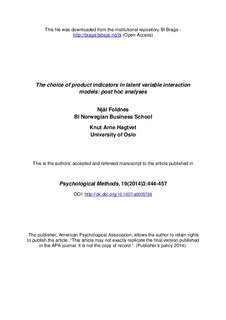The choice of product indicators in latent variable interaction models: post hoc analyses
Journal article, Peer reviewed
Permanent lenke
http://hdl.handle.net/11250/222323Utgivelsesdato
2014Metadata
Vis full innførselSamlinger
- Scientific articles [2181]
Sammendrag
The unconstrained product indicator (PI) approach is a simple and popular approach for
modeling nonlinear effects among latent variables. This approach leaves the practitioner to choose the PIs to be included in the model, introducing arbitrariness into the modeling. In contrast to previous Monte Carlo studies, we evaluated the PI approach by three post-hoc analyses applied to a real-world case adopted from a research effort in social psychology.
The measurement design applied three and four indicators for the two latent first-order
variables, leaving the researcher with a choice among more than 4000 possible PI
configurations. Sixty so-called matched-pair configurations that have been recommended in previous literature are of special interest. In the first post-hoc analysis we estimated the
interaction effect for all PI configurations, keeping the real-world sample fixed. The
estimated interaction effect was substantially affected by the choice of PIs, also across
matched-pair configurations. Subsequently, a post-hoc Monte Carlo study was conducted,
with varying sample sizes and data distributions. Convergence, bias, type I error and
power of the interaction test were investigated for each matched-pair configuration and the
all-pairs configuration. Variation in estimates across matched-pair configurations for a
typical sample was substantial. The choice of specific configuration significantly affected
convergence and the interaction test’s outcome. The all-pairs configuration performed
overall better than the matched-pair configurations. A further advantage of the all-pairs
over the matched-pairs approach is its unambiguity. The final study evaluates the all-pairs
configuration for small sample sizes, and compares it to the non-PI approach of LMS.
Beskrivelse
This article may not exactly replicate the final version published in the APA journal. It is not the copy of record. Final version at the publisher's website http://www.apa.org/pubs/journals/met/index.aspx
